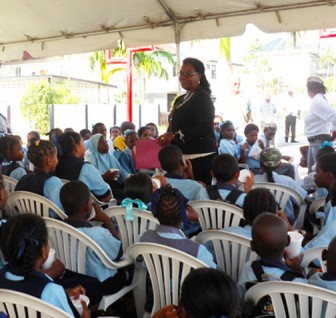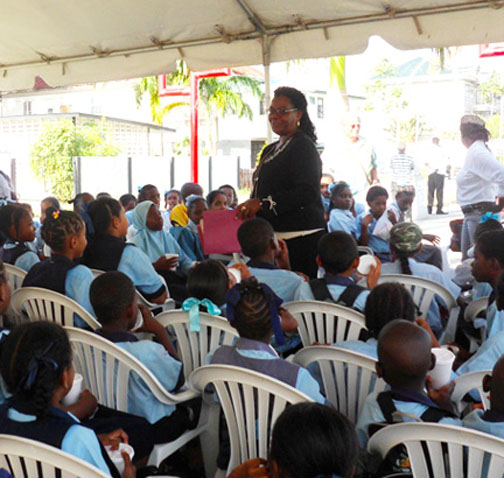By Savitri Persaud
Savitri Persaud was born in Guyana, and spent part of her childhood in Moblissa, off the Linden Highway. Savitri recently completed her Masters degree in Women and Gender Studies at the University of Toronto, and is now pursuing her PhD in Social and Political Thought at York University in Toronto.
 In October of last year, I penned a Diaspora column in response to the brutal murder of Neesa Gopaul, in which I argued that as Guyanese, we need to take collective ownership for the history of violence against women. We must unpack how these murders were made possible and how they continue to haunt the nation. Three weeks ago, on Tuesday, September 13th, Tessa Romascindo – a mother of seven – was violently hacked to death and her body dumped beneath bushes and grassy patches by her husband, Sewnarine Deonarine, at their home in ‘Rasta Town’ Laluni, off the Linden/Soesdyke Highway. The way in which Romascindo’s body was assaulted and discarded is eerily similar to that of Gopaul’s, whose corpse was discovered battered beyond recognition and disposed of off the same highway in a creek near the now abandoned Emerald Tower Resort. Another case, one that occurred years before the killings of Gopaul and Romascindo, is the story of Radika Singh – a 55-year-old woman from the community of Good Hope, East Coast Demerara, who was gruesomely attacked, sexually violated, murdered, and left at the side of a dirt road after she wandered into the neighbouring village of Bare Root, and was perceived as an old higue in 2007. These stories and the stories of other women who have been violently slain tell us something about the way in which women’s bodies can be rendered expendable and jettisoned like yesterday’s waste, today’s garbage, and tomorrow’s trash.
In October of last year, I penned a Diaspora column in response to the brutal murder of Neesa Gopaul, in which I argued that as Guyanese, we need to take collective ownership for the history of violence against women. We must unpack how these murders were made possible and how they continue to haunt the nation. Three weeks ago, on Tuesday, September 13th, Tessa Romascindo – a mother of seven – was violently hacked to death and her body dumped beneath bushes and grassy patches by her husband, Sewnarine Deonarine, at their home in ‘Rasta Town’ Laluni, off the Linden/Soesdyke Highway. The way in which Romascindo’s body was assaulted and discarded is eerily similar to that of Gopaul’s, whose corpse was discovered battered beyond recognition and disposed of off the same highway in a creek near the now abandoned Emerald Tower Resort. Another case, one that occurred years before the killings of Gopaul and Romascindo, is the story of Radika Singh – a 55-year-old woman from the community of Good Hope, East Coast Demerara, who was gruesomely attacked, sexually violated, murdered, and left at the side of a dirt road after she wandered into the neighbouring village of Bare Root, and was perceived as an old higue in 2007. These stories and the stories of other women who have been violently slain tell us something about the way in which women’s bodies can be rendered expendable and jettisoned like yesterday’s waste, today’s garbage, and tomorrow’s trash.
The similar appearances of brutality across these cases are what author Avery Gordon in her book Ghostly Matters: Haunting and the Sociological Imagination might call sociological hauntings. Gordon is describing something that might seem invisible but whose presence is symptomatic of something that is missing and unaddressed. ‘Haunting’ asks us to pay attention to the ways in which women’s bodies were historically rendered and are presently marked as needing to be sanctioned, controlled, and tamed through the use of violence.
There are stories that we tell ourselves about ourselves, stories that relate to the ways in which we see and treat women. Stories of ‘loose’ Indian indentured women, assertive and domineering African women, and even myths of all-powerful and threatening female folklore figures like the old higue and wata mama. Stories that are more than stories, as in the case of Radika Singh.
 The story of Radika Singh is both fascinating and macabre. According to the newspaper reports after her body was identified, she was a domestic worker with a history of mental illness who lived with her husband and son. As stated by her family, she had a tendency of wandering away when she refused to take medication intended to treat symptoms of depression. It is alleged that before dawn on the morning of April 27th, 2007, Singh ventured into the village of Bare Root. Based on the accounts of some residents, they believed Singh was an old higue who had drained the blood of an infant, leaving marks on the child’s body. Other reports from Bare Root indicated that when two villagers approached Singh they were met with growling and snarling sounds, which prompted them to alert other residents who came out, surrounded Singh, pelted her with rice, and beat her with a manicole broom and other objects. Singh’s family adamantly denied such accusations, citing her mental incapacitation as the reason for her wandering and apparent incoherence. One woman and two men were charged with Radika Singh’s murder, charges that were later dropped.
The story of Radika Singh is both fascinating and macabre. According to the newspaper reports after her body was identified, she was a domestic worker with a history of mental illness who lived with her husband and son. As stated by her family, she had a tendency of wandering away when she refused to take medication intended to treat symptoms of depression. It is alleged that before dawn on the morning of April 27th, 2007, Singh ventured into the village of Bare Root. Based on the accounts of some residents, they believed Singh was an old higue who had drained the blood of an infant, leaving marks on the child’s body. Other reports from Bare Root indicated that when two villagers approached Singh they were met with growling and snarling sounds, which prompted them to alert other residents who came out, surrounded Singh, pelted her with rice, and beat her with a manicole broom and other objects. Singh’s family adamantly denied such accusations, citing her mental incapacitation as the reason for her wandering and apparent incoherence. One woman and two men were charged with Radika Singh’s murder, charges that were later dropped.
Let me make it absolutely clear that what happened on that fateful morning in Bare Root was not the killing of an old higue. It was an act of communal violence and murder against a woman named Radika Singh, who was misrecognized as an old higue and made into a predatory and threatening creature who deserved to be killed.
We need to ask ourselves why and how it was so easy for us to draw on the myth of the old higue to explain away and ultimately justify the murder of Singh. The old higue is a household name in Guyana, and the tales of her adventures and misadventures are told and retold to people both young and old. She is a mainstay in our Guyanese oral tradition, inspires the artist’s paintbrush and palette, and is a common thread in the cultural fabric of the nation. Folklorist Wordsworth McAndrew’s famous poem “Ol’ Higue” is much loved and celebrated. “Ol’ Higue” is a part of the cultural patrimony of Guyana; parents and grandparents dramatically recount the tale of the old higue to children, and children retell this story to both their peers and elders, including in elocution performances in school and on the stage. It has become a way of reaffirming our ‘Guyaneseness,’ a proud folk tradition of the nation. But few of us stop to ask what kind of violence the story promotes, specifically against women, how it casts them as dangerous and as threatening the future (because they threaten innocent children), and how this tale requires their torture and murder. We must stop to think of how easy it is to pelt the old higue accusation against someone strange, someone not like us, someone who does not fit in. After the accusation of the old higue was pelted at Radika Singh, the violence against her body – including horrific sexual violence – was sanctioned and her only fate was death. In this case it led to the violent murder of a mentally disabled woman.
To conclude, let me share an experience that I had while I was in Guyana in June of this summer assisting Friends of the Walter Rodney Commemoration Committee in the organization of the 31st Commemoration of Walter Rodney’s murder, held at the Walter Rodney Memorial in Hadfield Street, Georgetown. It is an event that I believe attempts to grapple with these hauntings and challenge their violent legacies. The Commemoration was intended to educate a younger generation of Guyanese about the life and legacy of Dr. Walter Rodney; how as a scholar and activist, he was committed to using his education as part of a struggle to make an equal society, one in which poverty was abolished for women, men, and children of every race. Because it was an event tailored to a younger audience, storyteller Paulette Paul was asked to entertain the children by recounting traditional Guyanese folktales. She chose to retell Samaan – the tale of a compassionate tree of the same name. Samaan is not a story about the wickedness of the old higue. In fact, the old higue makes an appearance in this tale to visit Samaan after her voyage to Mars, not from feeding on infants. In this tale, it is the children who are described as being treacherous and monstrous in the ways that they relentlessly tease, taunt, and abuse Samaan, Fowl Mamma, Ole Man Papee, Baccoo, and the old higue. The old higue is portrayed as the victim of these children after they sound the alarm that she is hiding under Samaan. The children, along with the adults, batter her with the manicole broom and burn her until she dies. In this folktale, it is the old higue’s presence alone, not her actions, that renders her body a target for murder.
While many of the children knew about the legend of the old higue, the majority of them were unaware of Samaan. As Paul described how the tree fought relentlessly to protect the old higue from the children, women, and men who sought to kill her, the children in the crowd seemed perplexed. Why were they being told a counter-narrative about the old higue? After all, the only old higue that they knew was the sinister old woman who commits awful acts against children – just like them – by sucking their blood. In these moments of perplexity, something gave way when the children saw some semblance of themselves in the story, as the potential doers of violence against a creature that wronged no one. Through the art of storytelling and careful encouragement, Paul helped the young people in attendance to understand how the children in the story – who were also around their age – had a hand in the eventual beating death of the old higue. As Paul continued to recount the story, the demeanor of the children at the event started to change. Faces of perplexity became faces of understanding. Eyes of bewilderment gleamed with compassion and insight. There was a collective feeling that the violence in Samaan against the old higue was senseless. The violence was hidden beneath the pride with which we tell ourselves this is a Guyanese folktale. This pride instructs us to perform in specific ways in order to uphold our community. It makes us ignore the violence that underpins these stories that we tell ourselves about ourselves. When asked by Paul if the murder of the old higue was wrong, the children collectively exclaimed, “Yes!”
This is a moment of reckoning and transformation. It is a moment that not only compels us to retell the story of the old higue differently, but forces us to recount the life of Radika Singh and the lives of the women who have been violently killed before and after her differently. Samaan is a counter narrative that forces us to reckon with the ways in which the bodies of women are made into subservient others, susceptible to violence.
It is my hope that Guyana will first encounter its violent past, which seeps into its present; and then reckon with the murder of Radika Singh, Neesa Gopaul, Tessa Romascindo, and the countless women lost to violence. Put simply by Avery Gordon in her wonderful book, “Ultimately haunting is about how to transform a shadow of a life into an undiminished life whose shadows touch softly on the spirit of a peaceful reconciliation. In this necessarily collective undertaking, the end, which is not an ending at all, belongs to everyone.”






